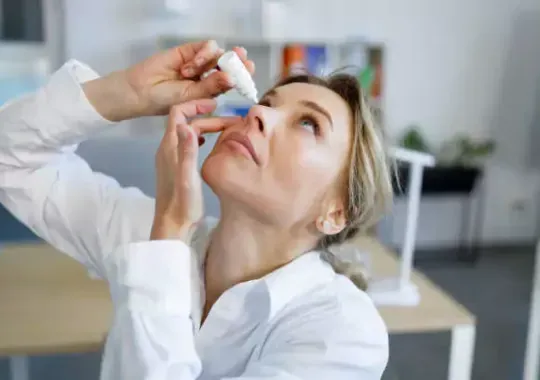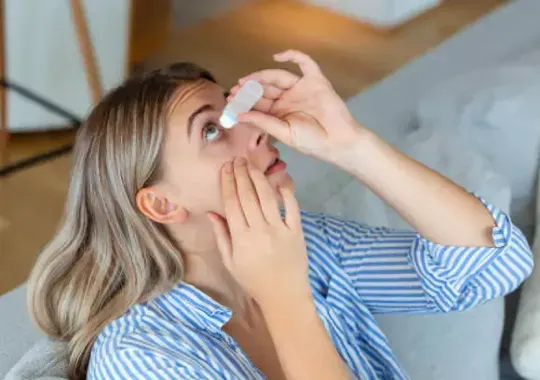Maintaining good vision health is crucial for overall well-being, and for many, eye drops are an essential part of their eye care routine. However, with a myriad of eye drop options available, it can be challenging to navigate and choose the safest ones for your eyes. In this guide, we'll explore the importance of selecting the right eye drops, discuss the different types available, and provide tips on how to use them safely to protect your vision. Whether you're looking to relieve dryness, redness, or irritation, understanding the safest eye drops for your vision health is key to maintaining clear and comfortable eyesight.
As Amazon affiliates we may earn a commission if you purchase a product at no cost to you.
Understanding Dry Eyes
Understanding Dry Eyes: Dry eyes are a common condition caused by various factors such as tear film instability, ocular surface inflammation, and damage. The tear film, which consists of water, oil, and mucus, helps lubricate the eyes and maintain their health. When the tear film is unstable or inadequate, it can lead to dryness and discomfort. This instability can result from insufficient tear production or issues with the outermost oil layer, causing tears to evaporate too quickly.
Additionally, inflammation and damage to the ocular surface can further exacerbate the symptoms of dry eyes. Common symptoms include burning, itching, stinging, and blurred vision, all of which can impact daily activities. Understanding the underlying causes of dry eyes is essential for choosing the safest and most effective treatment options.
Treatment Options: Managing Mild Dry Eye Symptoms
For those experiencing mild dry eye symptoms, over-the-counter artificial tears offer a convenient and effective treatment option. These eye drops work by lubricating the eyes, reducing dryness, and alleviating discomfort. Available in various formulations, they can cater to different types of dry eye conditions.
However, it's important to note that some artificial tears contain preservatives, which can potentially irritate or damage the eyes with frequent use. To avoid these potential adverse effects, preservative-free artificial tears are recommended. These preservative-free options come in single-dose vials, ensuring a fresh and sterile application each time.
Using preservative-free artificial tears can be particularly beneficial for long-term use, providing continuous relief without the risk of irritation or damage to the eyes. By choosing the right treatment option and following proper usage guidelines, individuals can effectively manage their mild dry eye symptoms and maintain optimal eye health.

Specialized Eye Drops
Specialized Eye Drops: Individuals with moderate to severe dry eyes or those with an evaporative component may benefit from specialized eye drops. These eye drops are often lipid-based or gel-based, providing a more viscous layer on the surface of the eye. This thicker layer helps to reduce tear evaporation and maintain moisture on the ocular surface, relieving symptoms of dryness and discomfort.
Lipid-based eye drops are particularly effective for addressing issues with the outermost oil layer of the tear film, which can contribute to tear instability and rapid evaporation. These specialized eye drops can provide longer-lasting relief for individuals with more severe dry eye symptoms, improving overall eye comfort and health. We recommend you check out these eyedrops on Amazon.
GenTeal Tears Lubricant Eye Drops.
TheraTears Extra Dry Eye Therapy Lubricating Eye Drops for Dry Eyes.
LUMIFY Redness Reliever Eye Drops.
Prescription Eye Drops
Prescription Eye Drops: In severe cases of dry eyes where over-the-counter and specialized eye drops provide insufficient relief, prescription eye drops may be necessary. These prescription eye drops, such as Restasis , Xiidra, or Siqua, are specifically formulated to target inflammation and reduce surface inflammation associated with dry eyes.
By addressing the underlying inflammatory processes, these prescription eye drops can help improve overall eye health and alleviate symptoms. However, it is essential to consult with an eye care professional to determine the most appropriate treatment option based on individual needs and severity of dry eye symptoms.

Consult an Eye Care Professional
Consulting an eye care professional is essential for anyone experiencing symptoms of dry eyes. These symptoms can include a scratchy or gritty feeling in the eyes, redness, sensitivity to light, and blurred vision. While mild symptoms can often be managed with over-the-counter artificial tears, more severe or persistent symptoms may require professional evaluation and treatment.
During your appointment, your eye care professional will conduct a comprehensive evaluation to determine the underlying cause of your dry eyes. This may involve assessing your medical history, conducting a thorough eye examination, and possibly performing additional tests to evaluate the quantity and quality of your tears.
Based on the findings of this evaluation, your eye care professional will develop a personalized treatment plan tailored to your specific needs. This plan may include recommendations for lifestyle changes, such as avoiding dry or windy environments, as well as the use of prescription eye drops or other treatments to help manage your symptoms.
By consulting an eye care professional, you can receive the expert guidance and treatment you need to effectively manage your dry eye symptoms and maintain optimal eye health. Don't hesitate to schedule an appointment if you are experiencing symptoms of dry eyes – your eyes will thank you for it!
Recommended Article

Frequently Asked Questions FAQs
What are the safest eye drops to use for dry eyes?
Discover the safest eye drops for long-lasting relief from dryness, with options that are gentle for regular use and tips on what ingredients to look for.
Can I use safe eye drops with contact lenses?
Identify which eye drops are the safest to use with contact lenses and how to avoid potential irritation or damage to your eyes and lenses.
What are the safest eye drops to use after eye surgery?
Learn about the safest post-operative eye drops recommended by ophthalmologists, designed to protect and heal your eyes without harsh chemicals.
Conclusion
In conclusion, selecting the safest eye drops for your vision health is essential for maintaining optimal eye care. By understanding the different types of eye drops available and their intended uses, you can make informed decisions that promote clear and comfortable eyesight. Remember to always follow the instructions provided by your eye care professional and use eye drops as directed. With proper care and attention, you can keep your eyes healthy and your vision sharp for years to come.










